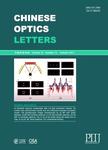Broadband fluorescence emission in Bi-doped silica glass prepared by laser additive manufacturing technology
Broadband fluorescence emission in Bi-doped silica glass prepared by laser additive manufacturing technology作者机构:Guangdong Provincial Key Laboratory of Nanophotonic Functional Materials and DevicesSouth China Normal UniversityGuangzhou 510006China Guangzhou Key Laboratory for Special Fiber Photonic DevicesSouth China Normal UniversityGuangzhou 510006China Guangdong Provincial Key Laboratory of Industrial Ultrashort Pulse Laser TechnologyShenzhen 518055China
出 版 物:《Chinese Optics Letters》 (中国光学快报(英文版))
年 卷 期:2020年第18卷第12期
页 面:30-33页
核心收录:
学科分类:0808[工学-电气工程] 080901[工学-物理电子学] 0809[工学-电子科学与技术(可授工学、理学学位)] 08[工学] 080401[工学-精密仪器及机械] 0804[工学-仪器科学与技术] 0805[工学-材料科学与工程(可授工学、理学学位)] 0803[工学-光学工程] 0702[理学-物理学]
基 金:the National Key Research and Developmen t Program of China(No.2019YFB2204002) Guangdong Basic and Applied Basic Research Foundation(No.2019A1515111120) Science and Technology Program of Guangzhou(No.202002030165) Young Scholar Foundation of South China Normal University(No.19KJ18) Special Funds for the Cultivation of Guangdong College Students' Scientific and Technological Innovation(“ Climbing Program”Special Funds)(No.pdjh2020a0146)
主 题:optical materials bisinuth-doped glass broadband fluorescence
摘 要:In this work, we proposed a feasible method to prepare the Bi/Al co-doped silica glass by using laser additive manufacturing technology. Bi was uniformly doped into the silica matrix. The hydroxyl content of the glass sample was measured to be 29.36 ppm. Using an 808 nm laser diode as the excitation source, a broadband near-infrared emission from 1000 to 1600 nm was obtained. The emission peak was centered at 1249 nm,and the corresponding FWHM was more than 400 nm. The results show that the laser additive manufacturing technology is promising to fabricate highly homogeneous Bi-doped core materials with broader emission band,which is beneficial to solving the communication capacity crunch and promotes the development of fiber communication in the upcoming fifth and sixth generation systems.



